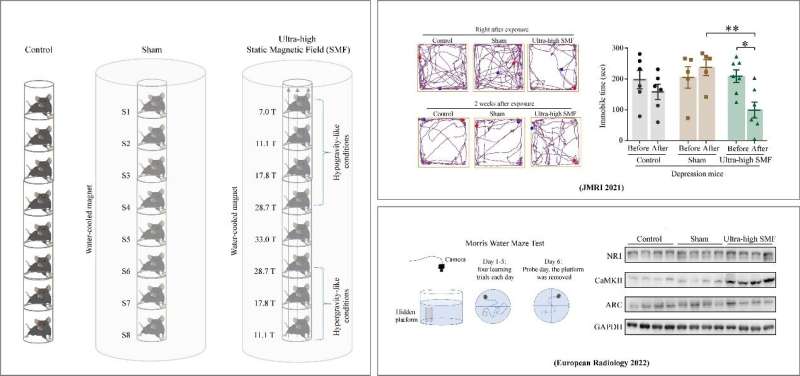High static magnetic field can relieve anxiety, scientists say

Prof. Zhang Xin's team at the Hefei Institutes of Physical Science of the Chinese Academy of Sciences has recently conducted a series of studies to test the biosafety and neurobehavioral effects of 33.0 Tesla (T) high static magnetic field (SMF) using the self-designed biological research platform of Steady High Magnetic Field Facility (SHMFF).
They for the first time reported the biosafety of 30 T level SMF and the neurobehavioral effects of 20 T and 30 T level SMF on healthy mice in in the Journal of Magnetic Resonance Imaging and European Radiology.
In recent years, ultra-high field magnetic resonance imaging (MRI) has developed rapidly due to its significant advantage of high imaging resolution. 7 T MRI has been clinically approved and 21.1 T MRI has been successfully used in rodents. However, studies on biosafety of high magnetic field above 20 T are still scarce, and there is still a gap in relevant studies above 30 T.
Based on the previous biosafety study of 3.5-23.0 T SMF, Zhang Xin's group further increased the magnetic field intensity and shortened the exposure time. Healthy C57BL/6J mice were exposed to 7.0-33.0 T SMF for one hour.
After exposure, all mice were routinely fed for two months. Except for a few metabolic and liver and hepatorenal function indicators affected by magnetic field, the whole blood count, organ coefficient on histomorphology of main organs were not seriously affected, and most of them were still within the normal reference range.
Meanwhile, behavioral tests showed that high SMF alleviated anxiety and improved social and spatial memory in mice within two months after exposure.
In addition, behavioral studies of healthy mice exposed to a 3.5-23.0 T magnetic field for two hours also found improved neurocognitive effects, which may be associated with increased calcium/calmodulin-dependent protein kinase II expression in the mouse hippocampus.
Zhang's group further found that 7 T SMF could effectively relieve symptoms of depressed mice. These results not only provide useful safety information for the development of ultra-high MRI, but may also indicate that high SMF has the potential to be a future antidepressant treatment.
More information: Md Hasanuzzaman Khan et al, Short- and long-term effects of 3.5–23.0 Tesla ultra-high magnetic fields on mice behaviour, European Radiology (2022). DOI: 10.1007/s00330-022-08677-8




















